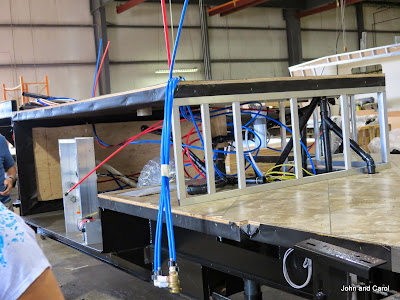While we were waiting for Scott to finish the work, we attended the 10 am factory tour to see how DRV builds 5th wheel trailers. We came away even more impressed with the quality of our Mobile Suites. And it helps to know what is hidden under the floors and inside the walls. Ryan Miller was the day's tour leader.

Here we could see the basic frame for a new trailer. They are just placing the floor, which has already been given a moisture-free barrier on the bottom side.

This is what the aluminum floor structure looks like before the sub-flooring and that black barrier is attached.

Vinyl floor squares are installed which allows individual pieces to be removed and replaced if they are damaged.

The front raised section framework is attached.

In some factories, there is a moving assembly line. At DRV, the individual units are moved by hand on this wheeled base, pushed by one a couple of workers.

Stacks of interior walls are moved from place to place.

Most RVs are built on I-beam chasses like this one. DRV uses I beams only on one less-expensive model.

All other DRV products, including our Mobile Suites, is built using 15" stacked box tube frames. The I-beam fram can support 9 1/2 pounds per square foot; the stacked box frame holds 21 pounds per square foot.

Ryan said that Trailer Life Magazine has reported that driving an RV down the road is like subjecting it to a 6.5 earthquake. In California, where buildings must be constructed to handle such earthquakes, components are assembled with screws and blue, not welding. So DRV uses screws and glue to fasten the studs to the trailer floor.

All the windows are framed with wood, helping to prevent transfer of cold or heat to the metal trailer frame.

The trailer insulation is made of wool, which is formaldehyde-free.

After the walls are up, the insulation is put in place.

Wiring is installed. Can you imagine keeping all this straight?

Next, a long sheet of fiberglass is attached to the exterior. First they put glue on studs, then glue it in place.

The covering is also screwed in place.

Next, the necessary openings for windows, doors and slide-out rooms are cut out. The slide-out rooms are also built in the factory by DRV craftsmen. The same roll of fiberglass is used to cover the slides as was used on the main trailer body.

We saw lots of evidence of the quality control used in the manufacturing. See all these instructions, comments on the fiberglass exterior of an RV. All are problems that must be corrected before the unit moves to the next stage.

We also saw light switches and window curtains being tested and cabinets wiped down with furniture polish, both inside and outside. At the DRV rally last month, we learned that each week a couple of newly-built units are randomly selected for a thorough quality inspection by department heads. That helps them keep ahead of possible poor work habits.
We have subjected our home on wheels to earthquakes and also found some issues with appliances that had been installed. But we continue to be impressed with the quality of construction and we love our home. Our factory experience yesterday just increased our confidence.

When I worked, I spent a lot of time in Indiana at RV Manufacturing plants. brings back memories of my work days. they do a very good job of building and inspecting their units.
ReplyDelete